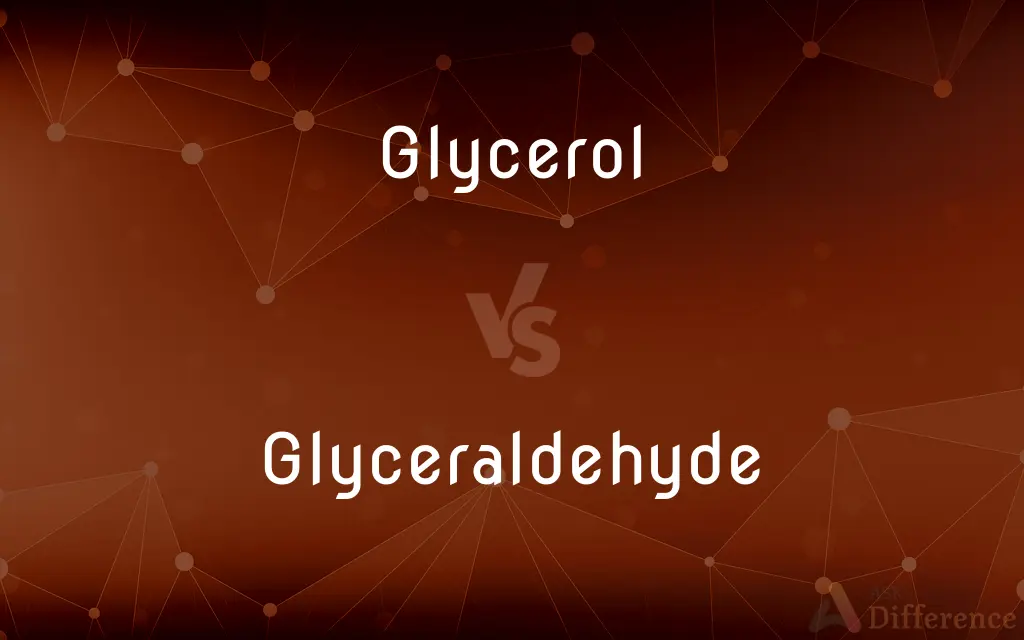Glycerol vs. Glyceraldehyde — What's the Difference?
By Tayyaba Rehman & Maham Liaqat — Updated on April 4, 2024
Glycerol is a simple polyol compound used in various industries, known for its moisturizing properties, whereas glyceraldehyde, a simple sugar, plays a crucial role in cellular metabolism and energy production.

Difference Between Glycerol and Glyceraldehyde
Table of Contents
ADVERTISEMENT
Key Differences
Glycerol is a thick, colorless, odorless liquid, widely recognized for its moisturizing properties. It's commonly found in food products, pharmaceuticals, and cosmetics, serving as a humectant, solvent, and sweetener. On the other hand, glyceraldehyde is a triose sugar, one of the simplest forms of sugar, which is crucial in the metabolic pathways of living cells, especially in processes like glycolysis and the Calvin cycle, where it participates in energy production and photosynthesis, respectively.
Glycerol, with its three hydroxyl (-OH) groups, makes it highly hygroscopic, attracting water from the air, which is why it's so effective as a moisturizer in skincare products. Glyceraldehyde, however, contains an aldehyde group and one hydroxyl group in its smallest monosaccharide form, playing a fundamental role in the biochemical pathway by acting as an intermediary substrate in the energy conversion process of cells.
In terms of structure, glycerol is an alcohol with a three-carbon chain, making it non-toxic and suitable for various uses, including as a sweetener in food and as a base for producing nitroglycerin, an essential component of dynamite. Glyceraldehyde's structure is pivotal in biochemistry as it exists in two isomeric forms (D- and L-glyceraldehyde), influencing the stereochemistry of higher carbohydrates and their biological interactions.
Despite their similarities in name and both being involved in biological processes, glycerol and glyceraldehyde serve vastly different purposes. Glycerol's applications span from industrial to personal care, emphasizing its versatility and safety. In contrast, glyceraldehyde's significance lies mainly within the biochemical processes, highlighting its role in the fundamental cellular functions and energy production.
The understanding of glycerol and glyceraldehyde underscores the diversity of organic compounds and their roles in both industrial applications and biological systems. Glycerol's role in improving product quality and human life through its physical properties contrasts with glyceraldehyde's critical involvement in the biochemistry of life, demonstrating the wide range of functionalities that similar yet distinct compounds can possess.
ADVERTISEMENT
Comparison Chart
Type
Polyol compound
Triose sugar
Primary Use
Humectant, solvent, sweetener in industries
Intermediate in metabolic pathways
Structure
Three-carbon chain with three hydroxyl groups
Three-carbon chain with an aldehyde and hydroxyl group
Key Properties
Hygroscopic, non-toxic, colorless, odorless liquid
Participates in energy production, isomeric forms
Industrial Applications
Pharmaceuticals, cosmetics, food, explosives
Limited to scientific research and studies
Biological Role
Not directly involved in metabolism
Crucial for glycolysis and Calvin cycle
Toxicity
Generally regarded as safe (GRAS)
N/A, but essential for cellular function
Compare with Definitions
Glycerol
A colorless, odorless liquid used as a solvent, sweetener, and humectant.
Glycerol is added to lotions to help retain moisture.
Glyceraldehyde
The simplest sugar and an intermediate in the glycolytic pathway.
Glyceraldehyde plays a role in breaking down glucose for energy.
Glycerol
A backbone component for triglycerides in fats and oils.
Breaking down triglycerides during digestion releases glycerol.
Glyceraldehyde
A research tool in biochemistry to study metabolic pathways.
Scientists use glyceraldehyde to understand energy conversion in cells.
Glycerol
A substance used in food products to improve texture and moisture.
Glycerol is found in low-fat food options to enhance taste.
Glyceraldehyde
A key molecule in the formation of advanced glycation end-products, which are significant in diabetes research.
Glyceraldehyde's reaction with proteins forms compounds studied in diabetes.
Glycerol
An ingredient in pharmaceutical formulations to improve smoothness and provide lubrication.
Glycerol is used in cough syrups for its soothing properties.
Glyceraldehyde
A compound existing in two isomeric forms, important for determining the stereochemistry of carbohydrates.
The D-form of glyceraldehyde is a precursor to many other sugars.
Glycerol
A compound used in the manufacturing of nitroglycerin, an explosive.
Glycerol is essential in creating dynamite.
Glyceraldehyde
A substance involved in the Calvin cycle of photosynthesis.
Glyceraldehyde is crucial for synthesizing glucose in plants.
Glycerol
Glycerol (; also called glycerine in British English or glycerin in American English) is a simple polyol compound. It is a colorless, odorless, viscous liquid that is sweet-tasting and non-toxic.
Glyceraldehyde
Glyceraldehyde (glyceral) is a triose monosaccharide with chemical formula C3H6O3. It is the simplest of all common aldoses.
Glycerol
A colourless, sweet, viscous liquid formed as a by-product in soap manufacture. It is used as an emollient and laxative, and for making explosives and antifreeze.
Glyceraldehyde
A sweet colorless crystalline solid, C3H6O3, that is an intermediate compound in carbohydrate metabolism.
Glycerol
A syrupy, sweet, colorless or yellowish liquid triol, C3H8O3, obtained from fats and oils as a byproduct of saponification and used as a solvent, antifreeze, plasticizer, and sweetener and in the manufacture of dynamite, cosmetics, liquid soaps, inks, and lubricants.
Glyceraldehyde
(carbohydrate) The aldotriose 2,3-dihydroxypropanal formed by oxidation of glycerol
Glycerol
(organic compound) 1,2,3-trihydroxy-propane or propan-1,2,3-triol; a trihydric alcohol
Glyceraldehyde
A sweet crystalline aldehyde formed by the breakdown of sugars
Glycerol
A syrupy sweet liquid obtained as a by-product in the manufacture of soap from animal or vegetable oils and fats; it is used as an antifreeze, a plasticizer, and a food sweetener and in the manufacture of dynamite, cosmetics etc.
Glycerol
Same as Glycerin.
Glycerol
A sweet syrupy trihydroxy alcohol obtained by saponification of fats and oils
Common Curiosities
Can the study of glyceraldehyde help understand diseases?
Yes, studying glyceraldehyde and its pathways can provide insights into metabolic diseases and conditions like diabetes.
Why is glycerol used in so many products?
Glycerol's non-toxicity and hygroscopic properties make it versatile for industrial and personal care products.
Is glyceraldehyde found in foods?
Glyceraldehyde is not typically listed as a food component but is a metabolic intermediate in organisms.
Is glycerol safe for consumption?
Glycerol is generally regarded as safe for consumption in regulated amounts.
Does glyceraldehyde have any industrial applications?
Its applications are mainly in scientific research rather than widespread industrial use.
Are glycerol and glyceraldehyde interchangeable in industry or biology?
No, they serve distinct functions in industry and biology and are not interchangeable.
Can glycerol be converted into glyceraldehyde in biological systems?
Not directly; glycerol and glyceraldehyde participate in different metabolic pathways.
How does glyceraldehyde contribute to energy production?
It's a key intermediate in glycolysis, leading to ATP production in cells.
Can glycerol be used in all types of food?
Glycerol is used in various foods, especially as a sweetener and texture enhancer, but its use depends on specific food regulations.
How does glycerol benefit the skin?
It attracts moisture to the skin, improving hydration and elasticity.
What makes glycerol different from other alcohols?
Its three hydroxyl groups make it more soluble in water and give it unique moisturizing properties.
Are there any health risks associated with glyceraldehyde?
As a sugar involved in metabolism, glyceraldehyde itself isn't associated with health risks but plays a role in biochemical processes.
Share Your Discovery

Previous Comparison
Help vs. Care
Next Comparison
Pip vs. StoneAuthor Spotlight
Written by
Tayyaba RehmanTayyaba Rehman is a distinguished writer, currently serving as a primary contributor to askdifference.com. As a researcher in semantics and etymology, Tayyaba's passion for the complexity of languages and their distinctions has found a perfect home on the platform. Tayyaba delves into the intricacies of language, distinguishing between commonly confused words and phrases, thereby providing clarity for readers worldwide.
Co-written by
Maham Liaqat















































